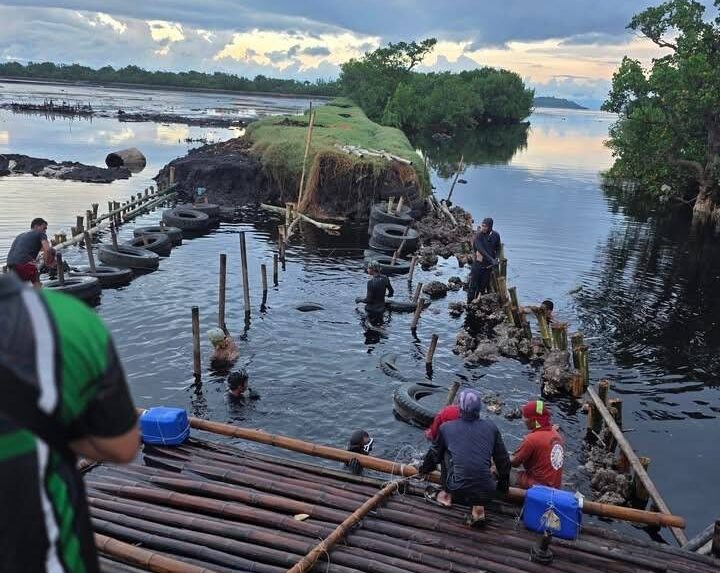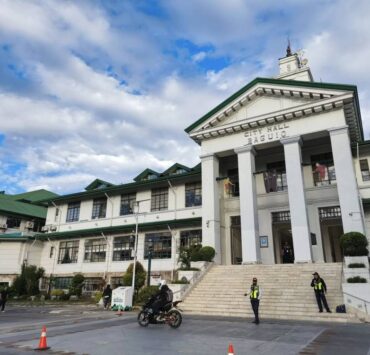‘Spent wash’ smears 6,000 hectares of Tañon Strait

DUMAGUETE CITY—Scientific teams mobilized last weekend by the Silliman University (SU) found that the Oct. 26 “spent wash” spill from the ethanol distillery of Universal Robina Corp. (URC) in Bais City, Negros Oriental, has spread to some 6,000 hectares (ha) of marine and coastal waters of the Tañon Strait Protected Seascape.
The affected area is about 6,000 grassy patches normally found within a running track in stadiums.
Preliminary results from on-site surveys and drone-based geographic information system mapping indicated that the “spent wash plume” has affected the country’s largest marine protected area, lamented Aileen Maypa, dean of the SU Institute of Environmental and Marine Sciences (IEMS) and a Pew Fellow for Marine Conservation.
The Tañon Strait Protected Seascape covers more than 500,000 ha between the islands of Negros and Cebu.
Extensive damage
According to data from both the SU and the Department of Environment and Natural Resources-Tañon Strait Protected Seascape (DENR-TSPS), “localized fish kills” were observed up to 7 kilometers from the spill source at a depth of 3 meters.
Fish pen and corral operators in the town of Manjuyod revealed to the scientists that their losses were valued at up to P1.8 million for at least one operator of grouper (lapu-lapu) fishstock.
“Extensive damage” was also noted in seaweed farms by Oct. 27, the peak of the fish kills.
Manjuyod hosts about 100 operators of fish pens and fish corrals, according to the Bantay Dagat (sea wardens) who participated in a rapid field assessment to determine the extent of the spill and severity of the fish kills, conducted by the SU-IEMS with the DENR-TSPS, the Philippine Coast Guard and URC.
Maypa, head of Silliman’s environmental emergency response team, said the findings will provide “scientific basis for guiding immediate response measures, and supporting evidence-based rehabilitation and management strategies” at the Tañon Strait.
The DENR-Negros Island Region had convened a multisectoral technical working group, chaired by regional Executive Director Charlie Fabre, to oversee emergency response operations, with Silliman contributing scientific expertise.
What happened
On the night of Oct. 26, the wastewater lagoon of the Bais distillery of Universal Robina Corp. collapsed, “releasing large volumes of molasses-based ethanol wastewater (spent wash or vinasse)” into Bais Bay.
The incident “caused severe water discoloration of the Bay, fish kills and algal blooms.”
“What happened in Bais Bay is gravely threatening the ecological integrity and biodiversity of the Tañon Strait,” Maypa said.
She stressed their findings form part of an ongoing investigation, as water quality and ecological conditions continue to be monitored in coordination with partner agencies. “Our goal is to provide science-based guidance to help protect livelihoods and ensure that recovery efforts are well-informed and effective,” she said.
Collaborative discussions are ongoing to “refine damage assessments, expand ecological investigations and formulate a comprehensive restoration plan aimed at ensuring the resilience and ecological integrity” of Bais Bay, Maypa said.
Oxygen depletion
Earlier on Nov. 1, the SU Angelo King Center for Research and Environmental Management, led by its director, Robert Guino-o II, also conducted a preliminary water quality assessment, which confirmed “dissolved oxygen depletion” in Bais Bay.
Guino-o warned that untreated molasses wastewater is “highly polluting and capable of rapidly depleting dissolved oxygen,” leading to fish kills, plankton and algal die-off.
He said untreated molasses wastewater is usually deep black to brown, and could affect seagrass beds, corals and algal beds there, noting how Bais serves as the “fisheries food basket” in Negros Oriental and the western side of Cebu.
Findings released on Nov. 8 showed that water outside the spent wash lagoon “has too much organic matter, which can harm aquatic life,” said Guino-o.
The study also found that the dissolved oxygen levels in several sites of Bais Bay—including Alangilanan, Tangculogan, and the Manjyod fish trap—were found to be lower than the safe standard of 6.0 parts per million.
“Low oxygen levels make it harder for fish and other aquatic organisms to survive,” he said.
An alcohol-like odor was also noted in most of the sites, linked to the presence of decaying algae. The waters and the seabed also remain discolored, “most likely caused by suspended particles or waste materials.”
Guino-o noted that the situation at Bais Bay returning to normal will not be a simple process. “Normal levels of BOD (biochemical oxygen demand) may require the interplay of various factors, including sea currents, temperature, tidal levels, ‘amihan’ (northeast monsoon) and ‘habagat’ (southwest monsoon), water acidity/alkalinity, water clarity, sunlight, microbial activities, etc.”
He added: “We hope that with the amihan-enhanced rainfall and sea currents (until January), the spent wash will be diluted. It will take a lot of oxygen to dissipate the spilled vinasse,”
“We strongly recommend the urgent repair of the collapsed lagoon and containment structures, the implementation of transparent and regular water quality monitoring, and strengthened multi-sectoral coordination to prevent further ecological damage,” read a statement from Silliman University, headed by president Betty Cernol-McCann.

















